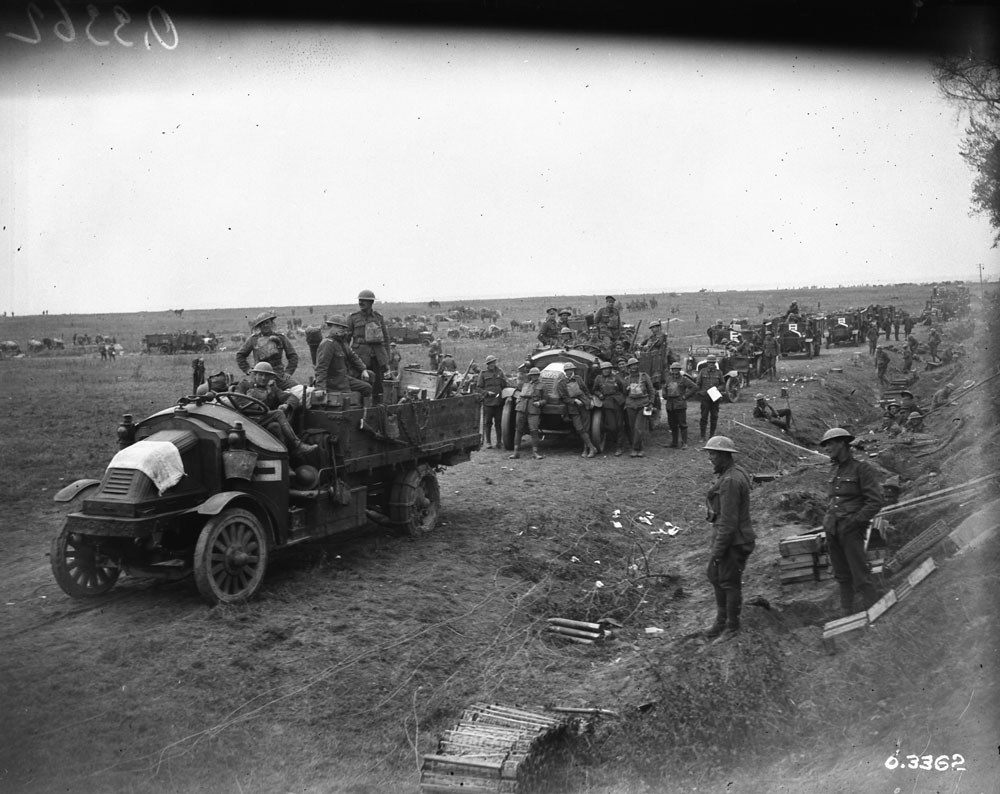Canadian Motor Machine Gun Brigade
Private John Millington 174876 born 10 November 1894 in London, England. A labourer standing 5′ 9″ tall with dark complexion, brown eyes and dark hair. Next of kin his sister Annie Millington, and his brother Alex Millington residing in the ‘Truth’ Ward at St George Infirmary, Wapping, England.

Attestation of Private John Millington
Private John Millington 174876 attested 31 August 1915 at Hamilton Armories, Ontario with the 86th Machine Gun Overseas Battalion. The 86th Battalion recruited in Hamilton as the first and only Machine Gun Battalion in the Commonwealth at this time.
Private John Millington forfeits one days pay in April 1916. John admitted to Military Hospital in Hamilton on 6 April 1916, Rheumatism, and later discharged to duty on 12 April 1916.

Private John Millington sailed per SS ADRIATIC from Halifax on 19 May 1916.
Reorganization of the CMGC
On 19 Aug 1916, the Canadian Motor Machine Gun Brigade created overseas by a reorganization of these MG units.
- A Battery a redesignation of the 1st Battery of the Automobile MG Bde
- B Battery a redesignation of the 2nd Battery of the Automobile MG Bde
- C Battery a redesignation of Borden’s Motor MG Battery (raised 1 Jul 1915 at Ottawa)
- D Battery a redesignation of Eaton’s Motor MG Battery (raised 1 Jul 1915 at Toronto)
- E Battery a redesignation of Boyle’s Yukon Motor MG Battery (raised 1915 in Yukon Territory)

Each battery divided into three sections. Also each section having two Colt machine guns, five motorcycles (three with sidecars), and a car. The battery led by 4 officers and had 45 other ranks.

The Canadian Machine Gun School established at Napier and Riseborough barracks amalgamated with the 86th (Machine Gun) Battalion to form the Canadian Machine Gun Depot.
Shorncliffe
Private John Millington SoS to 3rd Brigade, CMGC, Shorncliffe, 23 September 1916. John awarded One Good Conduct Badge in the Field, 8 September 1917.

Pte John Millington granted 14 days leave on 8 December 1917. John absorbed into 1st Battalion CMGC, 21 December 1917.

Private John Millington transferred to 1st Division, CMGC later on 15 March 1918.
Wounded
Private John Millington admitted to No 2 Canadian General Hospital, Le Treport, GSW wrist 5 September 1918.
Private John Millington Killed in Action
Private John Millington died 14 October 1918. Whilst with his Battery moving through Bois de la Bucqiere, South of Corbehem, at about 5.00 P.M., hit in the head and almost instantly killed by a piece of shrapnel from an enemy shell. John initially buried at Le Cluse Crucifix Cemetery, 51b.P.6.a.10.35, Plot 1, Row A, Grave 8. This cemetery no longer exists – a residential area today.

Medals sent to his brother Alex, now residing at 43 Falkland Road, Kentish Town, NW5. As of 25 August 1922, his Plaque unclaimed.
Chapel Corner Cemetery, Sauchy-Lestrée
Sauchy-Lestree captured by the 56th (London) Division on 27 September 1918, and the cemetery made and used by fighting units during the following five weeks. It contained 50 burials at the Armistice, and others then added from the surrounding battlefields and from the following cemeteries.
EPINOY ROAD CEMETERY, EPINOY, on the road from Sauchy-Lestree to Epinoy, just West of the point where it crosses the road from Sauchy-Cauchy to Haynecourt. Made by fighting units, and it contained the graves of 27 soldiers (mainly 2nd Yorkshire Regiment) and one airman from the United Kingdom and four soldiers from Canada, all of whom fell between the 26th September and the 14th October, 1918.

LECLUSE CRUCIFIX CEMETERY on the Southern outskirts of Lecluse village, and it contained the graves of 16 Canadian soldiers who fell in October 1918. Private John Millington’s body exhumed from here in March of 1920.

Chapel Corner Cemetery now contains 178 Great War burials, 29 of which are unidentified. The cemetery was designed by G H Goldsmith.
